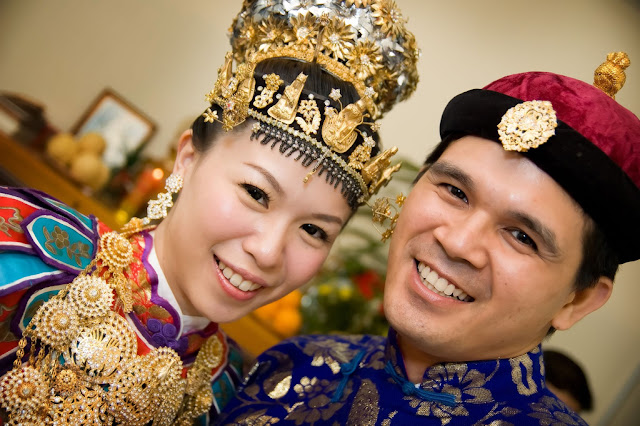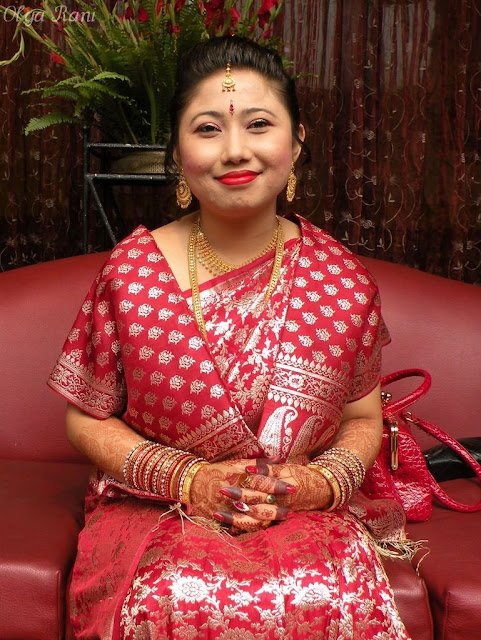During my last stay in Singapore a few months ago I visited the Peranakan Museum and was really impressed with the amazing examples of peranakan handicrafts:
beadwork, jewelry and textiles. A whole chamber of the museum was dedicated specifically to Peranakan weddings and I have to say that their wedding ensembles are one of the most beautiful, colourful and rich ones that I have ever seen.
First of all, who are the Peranakans? The term Peranakan generally refers to people of mixed Chinese and Malay/Indonesian heritage. Many Peranakans trace their origins to 15th century Malacca where their ancestors were thought to be Chinese traders who married local women. The Peranakans were also known as Straits Chinese as they were usually born in the British-controlled Straits Settlements of Singapore, Penang and Malacca. They combined the elements of the Chinese, Malay and sometimes European culture into their own.
Dressing up of a Peranakan bride starts with arranging her hair by the Mistress of Ceremonies. It is plated and coiled over the top of the bride's head, with the tail end made to look like a sharp spike and with its base strengthened by a gold circlet. The coiled hair represents the body of the auspicious dragon. Then about a hundred or even more gold and silver pins embellished with diamonds are carefully pushed one after another into the bun to cover the whole of it and to form a crown. The ends of the hairpins are shaped as flowers, insects, sea creatures, birds and other symbols intended to bless the bride. So, the bun needs to be really tight and firm to stand the weight of all those pins. A special pin with a dragon head is inserted at the front to signify the bride's status as queen for the day.

After all the pins are pushed into the hair a decorative band is tied firmly to the back of the bejeweled hairdo. The band has a fringe of beads as a symbol of virginity and is decorated with the gold figures of the Eight Immortals, the legendary saints from Chinese mythology who are considered to be signs of prosperity and longevity. Besides, there is a central figure of an old man sitting on a crane symbolizing longevity. The crane usually holds a dangling ornament in its beak. To complete the bride's headdress two curved pins are pushed into the hair in such way that each pin rests on the temples of the bride. These pins have gold flowers attached to them by strings so that each time the bride moves the flowers tremble delicately.
Aftrer the hair is done it is time for a heavy embroidered ceremonial gown. It is usually in rich turquoise or green colours and covered with gold thread embroidery traditionally depicting flowers and birds. The long broad sleeves of the gown end in bands of green, blue and yellow and are also embroidered with gold thread. Then a cape of small embroidered flaps which overlap one another is put around the shoulders of the bride. This cape represents the neck feathers of the phoenix, another mythological character that symbolizes the union of yin and yang. Four pieces of embroidered strips which look like neckties are then pinned to the cape, two in front and two at the back. These have tassels at their V-shaped ends. Hanging from the back of the cape in between the two bands is a coloured braid with intricate knots at intervals and ending in one long tassel. The most important part of this decoration is a small mirror to scare off any evil.
 Wedding necklace, Penang, late 19th-early20th century. Gilt silver, the Peranakan Museum of Singapore
Wedding necklace, Penang, late 19th-early20th century. Gilt silver, the Peranakan Museum of Singapore
 Wedding necklace, Malacca or Singapore, late 19th-early 20th century, gold. This necklace is made up of nearly 600 tiny circular rings, about 320 tiny rosettes along with the filigree work panels - nearly 1000 handcrafted parts. The Peranakan Museum of Singapore
Wedding necklace, Malacca or Singapore, late 19th-early 20th century, gold. This necklace is made up of nearly 600 tiny circular rings, about 320 tiny rosettes along with the filigree work panels - nearly 1000 handcrafted parts. The Peranakan Museum of Singapore
On the bride's chest a velvet bib is put and the family's heirloom brooches are pinned on it. Additionally gold and silver chains with filigree pendants and diamond necklaces are hung over it. On the last finger of her left hand the bride wears a ring to which is attached a stiff embroidered triangular handkerchief. The colour of this ornamental handkerchief always matches the colour of the costume worn.
 Singapore bride and groom, 1940
Singapore bride and groom, 1940
To complete the outfit the bride wears the soft cloth shoes with embroidered patterns of leaves and flowers. These shoes are tied to the ankles by cloth strips in the same manner as ballet shoes.
The bridegroom's costume consist of a short jacket of Manchu style worn over a longer gown which reaches the ankles, both intricately embroidered in gold thread with auspicious motifs such as peonies, cranes, mandarin ducks and phonixes. Underneath he wears a jacket and trousers made from white cotton. These were sewn by women with many children and when taken off after the wedding ceremony are not to be washed but have to be kept until the owner dies. The trousers are covered with embroidered leggings and on his head the groom wears a Mandarin cap of brocade with velvet rim on which is pinned a diamond shaped brooch.
The shoes can be of two types: either the soft embroidered Chinese shoes or half boots with thick soles. Whenever the groom appears in public he has to carry a fan even if it is folded, it is supposed to add an air of nobility to the look.
If you enjoyed this post please like my page on
Facebook. Thank you!

 Wedding necklace, Penang, late 19th-early 20th century. Gilt silver The Peranakan Museum collection
Wedding necklace, Penang, late 19th-early 20th century. Gilt silver The Peranakan Museum collection Wedding necklace, Penang, late 19th-early20th century. Gilt silver, the Peranakan Museum of Singapore
Wedding necklace, Penang, late 19th-early20th century. Gilt silver, the Peranakan Museum of Singapore  Wedding necklace, Malacca or Singapore, late 19th-early 20th century, gold. This necklace is made up of nearly 600 tiny circular rings, about 320 tiny rosettes along with the filigree work panels - nearly 1000 handcrafted parts. The Peranakan Museum of Singapore
Wedding necklace, Malacca or Singapore, late 19th-early 20th century, gold. This necklace is made up of nearly 600 tiny circular rings, about 320 tiny rosettes along with the filigree work panels - nearly 1000 handcrafted parts. The Peranakan Museum of Singapore
 Singapore bride and groom, 1940
Singapore bride and groom, 1940









I didn't know anything about Peranakan traditional wedding attire prior to reading this, so this post was very informative for me. I'm fascinated by how rich and detail this wedding attire is. Both the bride and the groom look like royalty. Splendid!
ReplyDeleteHow wonderful and fascinating. The colours and fabrics are stunning and the jewellery is exquisite. Thank you for sharing that with us. Its really interesting seeing how other cultures live
ReplyDeleteLynn xx
The colors and patterns, the ornate jewled and crafed items, and the beautiful mythology, it all combined to a magical post, dear. Learning mixed with such lovely images is very fun. I do not believe mirrors keep evil away. Every morning I awaken and look in the mirror and something frightening awaits me there :)P
ReplyDeleteWhat a weight of expectations and literally to carry!
ReplyDeleteI guess all women have long hair :-)
It all looks so beautiful and yet stifling!
We in the West have freer but less beautiful lives in a way.
We miss out on the richness of symbolism and tradition, but gain in individuality and freedom :-)
xo Jazzy Jack
Wow, look at the amazing colours and intricate work on these pieces. As always, you share some incredible clothing, styles and traditions with us, Olga, which I wouldn't learn about any other way, so thank you. Xx
ReplyDeleteWhat extraordinary colours and prints. So dazzling to the eye. I do enjoy reading about different customs especially relating to weddings. And the jewellery - so intricate and delicate.
ReplyDeletehttp://petitesilvervixen.blogspot.co.uk/
All these gowns are very nice but purple and white are the perfect one among them. Last month I attended a wedding at traditional wedding venues and wore a traditional dress. Everyone complemented my looks that day.
ReplyDeleteThankyou for sharing this beautiful and very helpful post. I really like your post. You can also check bridal makeup artist in vishakapatanam.
ReplyDeleteAnother awesome article. Very detailed and informative. Thanks for sharing!
ReplyDeleteSantorini Weddings
Santorini Wedding Planner
My aunt and uncle lived together for about forty years. So many years together and a divorce, but it happened. Read free senior dating sites to find a cool site. After a divorce, they find online communication, flirt, and constantly communicate. The site for adults is very cool and conveniently arranged, they say delight!
ReplyDeleteI just read your post on types of saree and thought you made some really great points. I especially liked your take on Directgharpe If you have a chance, I’d love it if you’d take a look at my blog GeorgetteSarees. I think it might be of interest to your readers. Thanks!
ReplyDelete